The economic impacts of dense, mixed-use developments have been established through a number of studies. In 1999, the Urban Land Institute published a study of four new walkable communities. This research claims that homebuyers were willing to pay $20,000 more for a house in a pedestrian-oriented neighborhood than for a similar home nearby (Ryan). A national survey of Americans' attitudes toward walkable communities revealed that "When thinking about deciding where to live, having sidewalks and places to take walks for exercise or fun is important to nearly eight in ten Americans (79 percent) and ‘very' important to four in ten (44 percent). Having areas to walk in the neighborhood rates third on a list of seven items asked in the survey, behind feeling safe from crime and the quality of public schools" (Belden, Russonello and Stewart).
Pedestrian-oriented communities also benefit commerce. According to social scientist Richard Florida, American business is increasingly dominated by what he calls the "Creative Class." Florida argues that companies – and by extension, cities – that cater to this emerging generation of diverse, highly educated workers are showing the strongest signs of economic success. The traits that attract this Creative Class are often reflected in walkable communities where an eclectic mix of restaurants, shops and recreational venues provide an exciting and inclusive atmosphere.
The knowledge-driven, service-oriented nature of the "New Economy" thrives on the networking, accessibility and creativity that walkable communities tend to develop (Ryan). A 2000 article in the Brookings Review cites a study in the American Economic Review that found by doubling county-wide population density, especially in urban areas, a 6 percent productivity increase could be seen throughout the rest of the state. The Brookings article argued that this, along with similar studies, makes a "compelling economic case for fostering the development of our densest and most diverse employment centers – commonly known as cities" (Haughwout).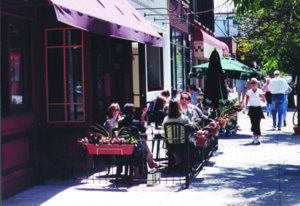
Good urban design also bears secondary impacts on local retail and economics. To attain the walkable "sense of place" that planners strive for, deterrents (like high-speed automobile traffic and wide streets with little pedestrian accessibility) must be minimized. By reducing street width, traffic is slowed, allowing for development in ways that high-speed thoroughfares would prevent while making existing commercial corridors more visible to drivers (because they must slow down and take in more of their surroundings) and more hospitable to pedestrians. Arguably, this increase in people on the street would serve local businesses.
A study of 22 U.S. cities that opened their multilane one-way streets to two-way traffic in an attempt to reduce vehicle speeds and encourage pedestrians reported many positive results. These included "improved business activity, increased investment on the street, improved traffic distribution (more choices on how to get around), helped create a more pedestrian-friendly environment, and produced a general feeling of improved ‘livability, quaintness' and ‘sense of community.' None reported significant negative effects or plans to convert back to one-way traffic" (Victoria Transport Policy Institute).
By minimizing infrastructure, cities also reduce long-term costs (though the upfront costs of retrofitting or redevelopment can be substantial), causing the tax rate to diminish while the tax base expands, creating a cycle of fiscal growth (Muro and Puentes). All of these benefits, when demonstrated across municipalities, form a greater gross regional product (GRP) than would otherwise exist (Basile Baumann Prost & Associates).
Additional economic benefits can be gained if walkable communities are planned with good access to transit. Transit boosts nearby land values by creating a well-connected, highly accessible space for homes and businesses (Cervero). It drives down the need for expanded infrastructure by concentrating construction along fewer roads, sewers and utility lines than auto-oriented sprawl would require – though, the costs associated with traffic congestion and some utilities can be higher in especially dense areas.
Municipalities without convenient rail or bus access could see their taxpayers and business patrons flee in favor of the more transit-oriented alternatives (Leinberger). Without specific attention paid to affordability, areas with transit access could become more exclusive, restricting transit for lower-income people who rely on it for transportation. To prevent this, affordable housing strategies should be implemented within TOD areas to maintain an even mix of incomes (Victoria Transport Policy Institute).
Over the past 20 years, cities across the region have rediscovered the compounding advantages of compact and efficient urban design. The city of Evanston raised its total equalized assessed value by 191 percent between 1985 and 2004 by developing around its transit stations. This allowed for its lowest tax rate since 1971 (Makarewicz and Benedict). In Park Forest, the private sector has invested over $24 million in and around the bustling downtown, which the city built on the site of a failing shopping center in 1995 (Congress for the New Urbanism). Similar positive scenarios have been replicated across the country.
Effects of Good Urban Design
Sep 18, 2013
Effects of Good Urban Design
Economic
Land Use and Development
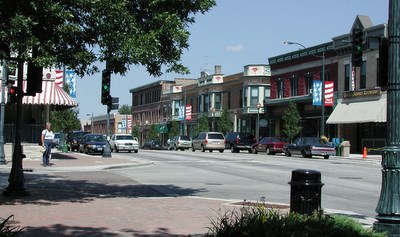
Most experts agree that compact urban design principles encourage infill (and discourage greenfield development) because many modern TODs and TNDs are developed in already-built-out areas (Northeast Midwest Institute and the Congress for the New Urbanism). Older communities often have valuable characteristics for proponents of good urban design, such as transit access, short block lengths, and mixed-use development. Therefore, the region-wide acceptance of good urban design principles would likely lead to reinvestment in older communities.
Even when built in greenfields, the compactness of well-designed, walkable communities minimizes development on open lands. In fact, some experts are encouraging developers and planners to look beyond infill because of greenfields' greater design flexibility, and the reality that infill development will not keep pace with the population growth expected in most metropolitan areas (Heid).
Transportation
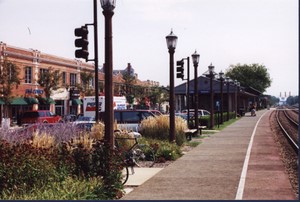 Compact development has been proven to reshape urban Transportation patterns – both in ridership and infrastructure. By better integrating transit into developments, communities have seen a shift from roads to rails as ridership numbers grow (Makarewicz and Benedict). This reduces the need for streets, allowing development to further focus on transit infrastructure and pedestrian corridors (Cervero). Yet, while TODs inherently provide a strong alternative to automobile travel, neighborhoods do not need transit to encourage non-automotive modes. The compact, walkable, mixed-use designs of TNDs – and some suburban retrofits – encourage pedestrian and bicycle travel where cars once dominated, whether transit is present or not (Coogan, Karash, Adler and Sallis).
Compact development has been proven to reshape urban Transportation patterns – both in ridership and infrastructure. By better integrating transit into developments, communities have seen a shift from roads to rails as ridership numbers grow (Makarewicz and Benedict). This reduces the need for streets, allowing development to further focus on transit infrastructure and pedestrian corridors (Cervero). Yet, while TODs inherently provide a strong alternative to automobile travel, neighborhoods do not need transit to encourage non-automotive modes. The compact, walkable, mixed-use designs of TNDs – and some suburban retrofits – encourage pedestrian and bicycle travel where cars once dominated, whether transit is present or not (Coogan, Karash, Adler and Sallis).
According to a study of King County, Washington, residents of the most walkable neighborhoods drive 26 percent fewer miles per day than those living in the most sprawling areas. A meta-analysis of many of these studies finds that households living in developments with twice the density, diversity of uses, accessible destinations and interconnected streets when compared to low-density sprawl drive about 33 percent less (Ewing et al.). Another study claims that transit ridership rates at mixed-use suburban employment centers are on average 5 percent and 10 percent higher than at single-use employment centers; and grid-like street patterns and pedestrian-friendly designs have been associated with transit-usage levels that are as much as 20 percent higher than usage levels at typical suburban subdivision designs (Cervero).
Good urban design can also provide better access to jobs by allowing workers to live closer to Transportation and by creating employment near transit nodes. According to a study of Evanston, TOD improvements allowed for 74,000 residents and 40,000 jobs within an 8-square-mile area. This enabled 40 percent of Evanston's residents to live where they worked, twice the rate of other suburbs in the region (Makarewicz and Benedict). On Chicago's West Side, the Bethel Center is a mixed-use development – operated by a community organization – that is connected to the Pulaski Green Line "El" stop. The impetus for this project came in 1992 under threats that the local El branch would close, adding insult to an economically injured neighborhood. When completed in 2005, the center itself created 100 jobs within the organization and throughout the businesses housed in the development. It also reinforced the viability of the train line, ensuring that it remained an operational portal to jobs outside the neighborhood (Grady and LeRoy).
A limitation of urban design on jobs/housing balance is that walkable communities are ineffective in isolation and must be integrated into the Transportation and employment networks of the greater region. According to a report by 1000 Friends of Oregon, "the creation of isolated new pedestrian oriented developments on vacant sites in auto-oriented suburbia will not produce the same kind of effects on mode choice that traditional neighborhoods have produced, unless the supportive pedestrian environment is integrated, through Transportation and land use planning, with proximity to a large number of employment opportunities and an adjacent network of other pedestrian oriented neighborhoods" (Parsons, Brickerhoff, Quade and Douglas).
Environmental
The environmental benefits of urban design are indirect, because they are linked to the Transportation impacts of urban design, but very significant nonetheless. This link is demonstrated clearly in a recent report, which "provides evidence on and insights into how much Transportation-related CO2 savings can be expected with compact development" (Ewing et al).
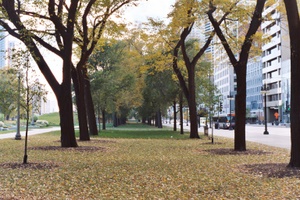
Other studies indicate that compact development can have environmental benefits. Compact development can reduce greenhouse gas emissions (Goldberg) and energy consumption (Allen) – but only if automobile traffic decreases. According to study in California, "TODs can help households reduce rates of greenhouse gas emissions by 2.5 to 3.7 tons per year." The study also states that "because of its location, design, and density, the Uptown District TOD in San Diego was estimated to have 20 percent less emissions per household compared with households in nearby developments" (Cervero). Similarly, every 1 percent shift of automobile mileage to a non-motorized mode has been shown to reduce energy consumption and emissions by 2 to 4 percent (Victoria Transport Policy Institute).
Good design can also benefit stormwater quality on the urban fringe by discouraging greenfield development – however this only translates to an overall improvement if drainage systems at the infill sites are properly equipped for greater densities, and stormwater-polluting automobile traffic is reduced (Natural Resources Defense Council). Compact development also simplifies and economizes drainage systems by concentrating them in a smaller area than sprawling development would require. Two studies in New Jersey claim that compact development can achieve a 30 percent reduction in runoff and an 83 percent reduction in water consumption compared with conventional suburban development (Urban Land Institute).
Quality of Life
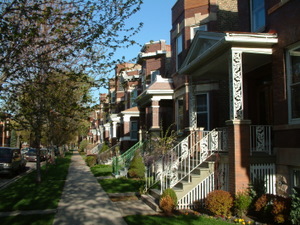 At its core, good urban design is essentially a quality-of-life issue. Economic efficiency and environmental stewardship mean nothing unless they are represented in places where people actually want to live. From public health to community character to accessibility for the disabled, modern design principles deliver positive contributions to the overall livability of a neighborhood (Centers for Disease Control and Prevention). As far as quality-of-life elements go, community character is arguably the most visible beneficiary of good design. For many reasons, compact, walkable neighborhoods make for friendly, unique, and beautiful communities. Examples of this have been seen in places like Arlington Heights and LaGrange, where heavy investment around transit stations led to a complete revitalization of the surrounding neighborhoods, complete with streetscape improvements and expanded greenspace (Basile Baumann Prost and Associates).
At its core, good urban design is essentially a quality-of-life issue. Economic efficiency and environmental stewardship mean nothing unless they are represented in places where people actually want to live. From public health to community character to accessibility for the disabled, modern design principles deliver positive contributions to the overall livability of a neighborhood (Centers for Disease Control and Prevention). As far as quality-of-life elements go, community character is arguably the most visible beneficiary of good design. For many reasons, compact, walkable neighborhoods make for friendly, unique, and beautiful communities. Examples of this have been seen in places like Arlington Heights and LaGrange, where heavy investment around transit stations led to a complete revitalization of the surrounding neighborhoods, complete with streetscape improvements and expanded greenspace (Basile Baumann Prost and Associates).
Often, strictly cosmetic improvements like increased street lighting can prompt dramatic effects. In a study of streetlights' effect on perceptions of safety and crime, 61 percent of respondents thought that crime reduced in the community that received more streetlights and 94 percent thought the lights made it easier to recognize others while also aesthetically enhancing the area (Painter). According to a study of Lodi, California, $4.5 million worth of streetscape and pedestrian improvements were "credited with attracting 60 new businesses, decreasing the vacancy rates from 18 percent to 6 percent and increasing downtown sales tax revenue by 30 percent (Ryan Synder Associates).
However, good urban design comprises more than new resources; it's also about embracing the old. Compact, mixed-use development (a common paradigm before the advent of the automobile) was popular at the origin of many older municipalities, so re-branding these aging downtowns as "New Urbanist" is a way of advocating historic preservation. In fact, the National Trust for Historic Preservation's "Main Street" Program facilitates preservation and downtown revitalization using many principles outlined in the latest planning literature.
If done right, urban design also contributes to public heath and safety. The appeal of well-designed streets attracts more pedestrians who unwittingly keep watch over one another – while improved streetscapes and traffic calming devices provide buffers between pedestrians, bicyclists and automobile traffic (Cervero et. al.). These added incentives to walk or bike, instead of drive, promote exercise (Goldberg, Frank/Engelke) and social connections among neighbors (Jacobs). A number of studies have linked obesity to characteristics of the built environment, concluding that building more walkable communities contributes directly to public health (Ewing et al).
Even the simple fact that more pedestrians are on the street actually decreases the likelihood that one will be struck by a driver. According to various studies, as drivers become acclimated to driving around pedestrians, they unconsciously become more cautious and attentive overall (Transportation Alternatives).
Sep 18, 2013
Effects of Good Urban Design
Economic
The economic impacts of dense, mixed-use developments have been established through a number of studies. In 1999, the Urban Land Institute published a study of four new walkable communities. This research claims that homebuyers were willing to pay $20,000 more for a house in a pedestrian-oriented neighborhood than for a similar home nearby (Ryan). A national survey of Americans' attitudes toward walkable communities revealed that "When thinking about deciding where to live, having sidewalks and places to take walks for exercise or fun is important to nearly eight in ten Americans (79 percent) and ‘very' important to four in ten (44 percent). Having areas to walk in the neighborhood rates third on a list of seven items asked in the survey, behind feeling safe from crime and the quality of public schools" (Belden, Russonello and Stewart).
Pedestrian-oriented communities also benefit commerce. According to social scientist Richard Florida, American business is increasingly dominated by what he calls the "Creative Class." Florida argues that companies – and by extension, cities – that cater to this emerging generation of diverse, highly educated workers are showing the strongest signs of economic success. The traits that attract this Creative Class are often reflected in walkable communities where an eclectic mix of restaurants, shops and recreational venues provide an exciting and inclusive atmosphere.
The knowledge-driven, service-oriented nature of the "New Economy" thrives on the networking, accessibility and creativity that walkable communities tend to develop (Ryan). A 2000 article in the Brookings Review cites a study in the American Economic Review that found by doubling county-wide population density, especially in urban areas, a 6 percent productivity increase could be seen throughout the rest of the state. The Brookings article argued that this, along with similar studies, makes a "compelling economic case for fostering the development of our densest and most diverse employment centers – commonly known as cities" (Haughwout).
Good urban design also bears secondary impacts on local retail and economics. To attain the walkable "sense of place" that planners strive for, deterrents (like high-speed automobile traffic and wide streets with little pedestrian accessibility) must be minimized. By reducing street width, traffic is slowed, allowing for development in ways that high-speed thoroughfares would prevent while making existing commercial corridors more visible to drivers (because they must slow down and take in more of their surroundings) and more hospitable to pedestrians. Arguably, this increase in people on the street would serve local businesses.
A study of 22 U.S. cities that opened their multilane one-way streets to two-way traffic in an attempt to reduce vehicle speeds and encourage pedestrians reported many positive results. These included "improved business activity, increased investment on the street, improved traffic distribution (more choices on how to get around), helped create a more pedestrian-friendly environment, and produced a general feeling of improved ‘livability, quaintness' and ‘sense of community.' None reported significant negative effects or plans to convert back to one-way traffic" (Victoria Transport Policy Institute).
By minimizing infrastructure, cities also reduce long-term costs (though the upfront costs of retrofitting or redevelopment can be substantial), causing the tax rate to diminish while the tax base expands, creating a cycle of fiscal growth (Muro and Puentes). All of these benefits, when demonstrated across municipalities, form a greater gross regional product (GRP) than would otherwise exist (Basile Baumann Prost & Associates).
Additional economic benefits can be gained if walkable communities are planned with good access to transit. Transit boosts nearby land values by creating a well-connected, highly accessible space for homes and businesses (Cervero). It drives down the need for expanded infrastructure by concentrating construction along fewer roads, sewers and utility lines than auto-oriented sprawl would require – though, the costs associated with traffic congestion and some utilities can be higher in especially dense areas.
Municipalities without convenient rail or bus access could see their taxpayers and business patrons flee in favor of the more transit-oriented alternatives (Leinberger). Without specific attention paid to affordability, areas with transit access could become more exclusive, restricting transit for lower-income people who rely on it for transportation. To prevent this, affordable housing strategies should be implemented within TOD areas to maintain an even mix of incomes (Victoria Transport Policy Institute).
Over the past 20 years, cities across the region have rediscovered the compounding advantages of compact and efficient urban design. The city of Evanston raised its total equalized assessed value by 191 percent between 1985 and 2004 by developing around its transit stations. This allowed for its lowest tax rate since 1971 (Makarewicz and Benedict). In Park Forest, the private sector has invested over $24 million in and around the bustling downtown, which the city built on the site of a failing shopping center in 1995 (Congress for the New Urbanism). Similar positive scenarios have been replicated across the country.
Land Use and Development

Most experts agree that compact urban design principles encourage infill (and discourage greenfield development) because many modern TODs and TNDs are developed in already-built-out areas (Northeast Midwest Institute and the Congress for the New Urbanism). Older communities often have valuable characteristics for proponents of good urban design, such as transit access, short block lengths, and mixed-use development. Therefore, the region-wide acceptance of good urban design principles would likely lead to reinvestment in older communities.
Even when built in greenfields, the compactness of well-designed, walkable communities minimizes development on open lands. In fact, some experts are encouraging developers and planners to look beyond infill because of greenfields' greater design flexibility, and the reality that infill development will not keep pace with the population growth expected in most metropolitan areas (Heid).
Transportation
 Compact development has been proven to reshape urban Transportation patterns – both in ridership and infrastructure. By better integrating transit into developments, communities have seen a shift from roads to rails as ridership numbers grow (Makarewicz and Benedict). This reduces the need for streets, allowing development to further focus on transit infrastructure and pedestrian corridors (Cervero). Yet, while TODs inherently provide a strong alternative to automobile travel, neighborhoods do not need transit to encourage non-automotive modes. The compact, walkable, mixed-use designs of TNDs – and some suburban retrofits – encourage pedestrian and bicycle travel where cars once dominated, whether transit is present or not (Coogan, Karash, Adler and Sallis).
Compact development has been proven to reshape urban Transportation patterns – both in ridership and infrastructure. By better integrating transit into developments, communities have seen a shift from roads to rails as ridership numbers grow (Makarewicz and Benedict). This reduces the need for streets, allowing development to further focus on transit infrastructure and pedestrian corridors (Cervero). Yet, while TODs inherently provide a strong alternative to automobile travel, neighborhoods do not need transit to encourage non-automotive modes. The compact, walkable, mixed-use designs of TNDs – and some suburban retrofits – encourage pedestrian and bicycle travel where cars once dominated, whether transit is present or not (Coogan, Karash, Adler and Sallis).
According to a study of King County, Washington, residents of the most walkable neighborhoods drive 26 percent fewer miles per day than those living in the most sprawling areas. A meta-analysis of many of these studies finds that households living in developments with twice the density, diversity of uses, accessible destinations and interconnected streets when compared to low-density sprawl drive about 33 percent less (Ewing et al.). Another study claims that transit ridership rates at mixed-use suburban employment centers are on average 5 percent and 10 percent higher than at single-use employment centers; and grid-like street patterns and pedestrian-friendly designs have been associated with transit-usage levels that are as much as 20 percent higher than usage levels at typical suburban subdivision designs (Cervero).
Good urban design can also provide better access to jobs by allowing workers to live closer to Transportation and by creating employment near transit nodes. According to a study of Evanston, TOD improvements allowed for 74,000 residents and 40,000 jobs within an 8-square-mile area. This enabled 40 percent of Evanston's residents to live where they worked, twice the rate of other suburbs in the region (Makarewicz and Benedict). On Chicago's West Side, the Bethel Center is a mixed-use development – operated by a community organization – that is connected to the Pulaski Green Line "El" stop. The impetus for this project came in 1992 under threats that the local El branch would close, adding insult to an economically injured neighborhood. When completed in 2005, the center itself created 100 jobs within the organization and throughout the businesses housed in the development. It also reinforced the viability of the train line, ensuring that it remained an operational portal to jobs outside the neighborhood (Grady and LeRoy).
A limitation of urban design on jobs/housing balance is that walkable communities are ineffective in isolation and must be integrated into the Transportation and employment networks of the greater region. According to a report by 1000 Friends of Oregon, "the creation of isolated new pedestrian oriented developments on vacant sites in auto-oriented suburbia will not produce the same kind of effects on mode choice that traditional neighborhoods have produced, unless the supportive pedestrian environment is integrated, through Transportation and land use planning, with proximity to a large number of employment opportunities and an adjacent network of other pedestrian oriented neighborhoods" (Parsons, Brickerhoff, Quade and Douglas).
Environmental
The environmental benefits of urban design are indirect, because they are linked to the Transportation impacts of urban design, but very significant nonetheless. This link is demonstrated clearly in a recent report, which "provides evidence on and insights into how much Transportation-related CO2 savings can be expected with compact development" (Ewing et al).

Other studies indicate that compact development can have environmental benefits. Compact development can reduce greenhouse gas emissions (Goldberg) and energy consumption (Allen) – but only if automobile traffic decreases. According to study in California, "TODs can help households reduce rates of greenhouse gas emissions by 2.5 to 3.7 tons per year." The study also states that "because of its location, design, and density, the Uptown District TOD in San Diego was estimated to have 20 percent less emissions per household compared with households in nearby developments" (Cervero). Similarly, every 1 percent shift of automobile mileage to a non-motorized mode has been shown to reduce energy consumption and emissions by 2 to 4 percent (Victoria Transport Policy Institute).
Good design can also benefit stormwater quality on the urban fringe by discouraging greenfield development – however this only translates to an overall improvement if drainage systems at the infill sites are properly equipped for greater densities, and stormwater-polluting automobile traffic is reduced (Natural Resources Defense Council). Compact development also simplifies and economizes drainage systems by concentrating them in a smaller area than sprawling development would require. Two studies in New Jersey claim that compact development can achieve a 30 percent reduction in runoff and an 83 percent reduction in water consumption compared with conventional suburban development (Urban Land Institute).
Quality of Life
 At its core, good urban design is essentially a quality-of-life issue. Economic efficiency and environmental stewardship mean nothing unless they are represented in places where people actually want to live. From public health to community character to accessibility for the disabled, modern design principles deliver positive contributions to the overall livability of a neighborhood (Centers for Disease Control and Prevention). As far as quality-of-life elements go, community character is arguably the most visible beneficiary of good design. For many reasons, compact, walkable neighborhoods make for friendly, unique, and beautiful communities. Examples of this have been seen in places like Arlington Heights and LaGrange, where heavy investment around transit stations led to a complete revitalization of the surrounding neighborhoods, complete with streetscape improvements and expanded greenspace (Basile Baumann Prost and Associates).
At its core, good urban design is essentially a quality-of-life issue. Economic efficiency and environmental stewardship mean nothing unless they are represented in places where people actually want to live. From public health to community character to accessibility for the disabled, modern design principles deliver positive contributions to the overall livability of a neighborhood (Centers for Disease Control and Prevention). As far as quality-of-life elements go, community character is arguably the most visible beneficiary of good design. For many reasons, compact, walkable neighborhoods make for friendly, unique, and beautiful communities. Examples of this have been seen in places like Arlington Heights and LaGrange, where heavy investment around transit stations led to a complete revitalization of the surrounding neighborhoods, complete with streetscape improvements and expanded greenspace (Basile Baumann Prost and Associates).
Often, strictly cosmetic improvements like increased street lighting can prompt dramatic effects. In a study of streetlights' effect on perceptions of safety and crime, 61 percent of respondents thought that crime reduced in the community that received more streetlights and 94 percent thought the lights made it easier to recognize others while also aesthetically enhancing the area (Painter). According to a study of Lodi, California, $4.5 million worth of streetscape and pedestrian improvements were "credited with attracting 60 new businesses, decreasing the vacancy rates from 18 percent to 6 percent and increasing downtown sales tax revenue by 30 percent (Ryan Synder Associates).
However, good urban design comprises more than new resources; it's also about embracing the old. Compact, mixed-use development (a common paradigm before the advent of the automobile) was popular at the origin of many older municipalities, so re-branding these aging downtowns as "New Urbanist" is a way of advocating historic preservation. In fact, the National Trust for Historic Preservation's "Main Street" Program facilitates preservation and downtown revitalization using many principles outlined in the latest planning literature.
If done right, urban design also contributes to public heath and safety. The appeal of well-designed streets attracts more pedestrians who unwittingly keep watch over one another – while improved streetscapes and traffic calming devices provide buffers between pedestrians, bicyclists and automobile traffic (Cervero et. al.). These added incentives to walk or bike, instead of drive, promote exercise (Goldberg, Frank/Engelke) and social connections among neighbors (Jacobs). A number of studies have linked obesity to characteristics of the built environment, concluding that building more walkable communities contributes directly to public health (Ewing et al).
Even the simple fact that more pedestrians are on the street actually decreases the likelihood that one will be struck by a driver. According to various studies, as drivers become acclimated to driving around pedestrians, they unconsciously become more cautious and attentive overall (Transportation Alternatives).